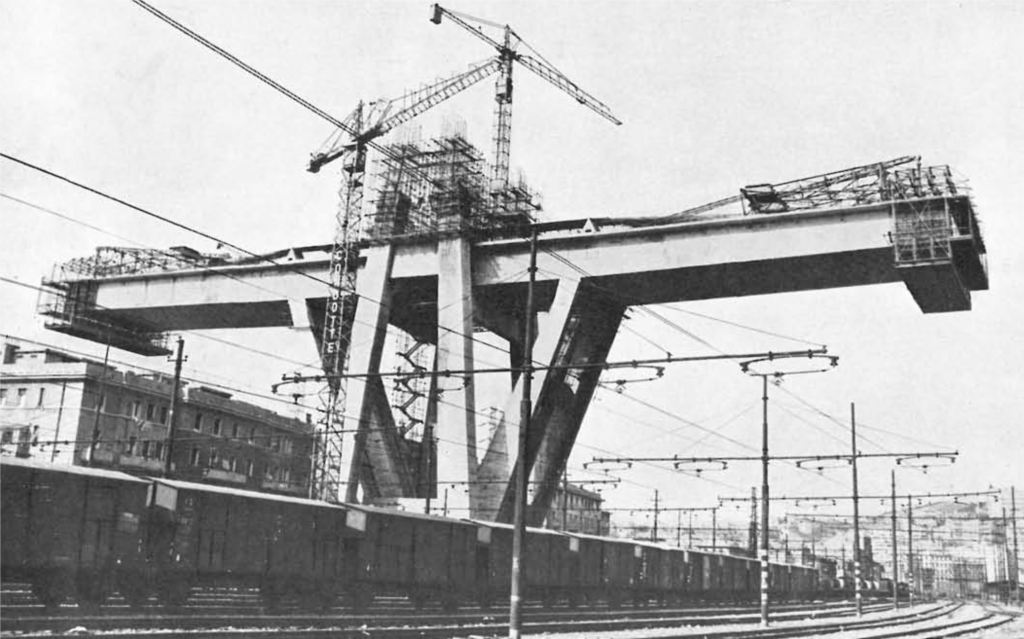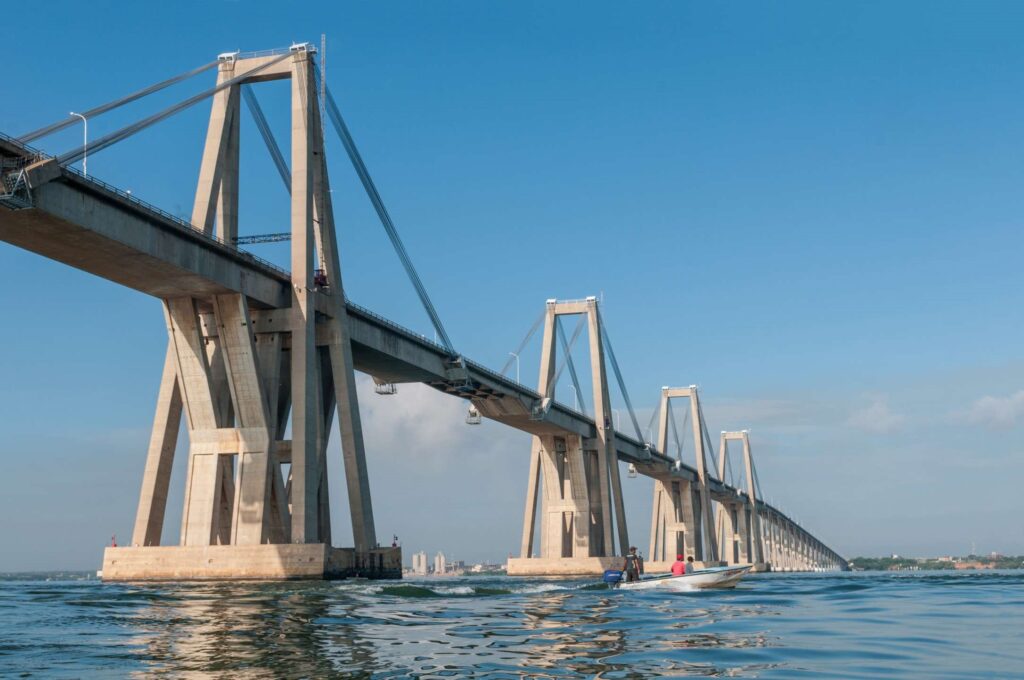Link zur deutschen Version: Riccardo Morandi – Pionier im Brückenbau oder schlechter Ingenieur?
Morandi’s Polcevera Viaduct
The Polcevera Viaduct, over a kilometre long and built between 1963 and 1967, carried the A10 motorway at a height of approximately 40 m over the Polcevera River, the Turin-Genoa railway line, two marshalling yards and an industrial area. Soon after its inauguration (see picture gallery) the three prominent 90 m high pylons supporting the approximately 220 m long main spans made the viaduct a landmark of Genoa and one of Riccardo Morandi’s most famous bridges.
The largest European viaduct at the time (see video) was innovative in several respects, even though Morandi adopted much from his bridge over Lake Maracaibo in Venezuela, completed in 1962. For example, the main spans of both viaducts are designed as multi-span cable-stayed bridges, the pylons are arranged similarly, and the standard spans are composed of prefabricated elements. However, for the Polcevera viaduct, Morandi used prestressed concrete tendons as stay cables for the first time to increase stiffness, and the main spans were cantilevered using temporary tendons, which would be challenging even today considering the large spans.

Due to the high degree of prefabrication and the cantilever construction, the Polcevera Viaduct could be built very quickly. Since the plan approval by the railway operators took some time, the execution took longer than for the more than eight kilometre long bridge over Lake Maracaibo, which was built in a record time of only 40 months (!). Without the delays mentioned, however, the main spans could have been executed in only 23 months [1].

Moreover, the Polcevera Viaduct was an extremely economic and efficient structure that, for example, consumed just one third of the (then expensive) prestressing steel per square metre of bridge area as the Bendorf Bridge, which was built at the same time and with a comparable main span across the Rhine near Koblenz. Compared to the now completed new bridge designed by Renzo Piano, the resource consumption and greenhouse gas emissions of Morandi’s Polcevera Viaduct were significantly lower, despite its significantly larger spans: The replacing bridge is statically inefficient due to the static system (carrying a large part of the loads as single-span girders) and the cross-sectional design (much material in the area of the neutral axis). While the former can be justified by the required fast erection of the single-span steel girders, the purely formal design of the cross-section (which apparently should resemble a vessel) is hard to understand: a statically efficient, lightweight cross-section would have been much more economical and climate-friendly, as well as beneficial for the fast erection, and could certainly have been designed aesthetically, too.
Collapse
Almost exactly three years ago, on 14 August 2018, an approximately 250 m long section around the western pylon collapsed, killing 43 people. To the best of our current knowledge [2], the collapse was triggered by the rupture of a stay cable, which led to the collapse of the entire pylon with the associated part of the superstructure, including the adjacent hang-in girders. The stay cable, which was designed as a prestressed concrete tension member, broke near the upper anchorage due to severe corrosion caused by the inadequate and partly even missing injection of the ducts in this area.
Weaknesses of the structural concept
After this tragedy, a number of professionals heavily criticised the concept of the bridge and Riccardo Morandi as engineer. Some of the criticisms made are simply wrong, and in part show a lack of expertise of the critics. For example, it was argued that the concept of the bridge was generally weak, which would be evident from the fact that only three such bridges had been built worldwide. In reality, there are many more such bridges – designed both by Morandi and by other designers – especially in Germany, where they are known as “Zügelgurtbrücken”. More specifically, it was criticised that the pylons were far too stiff, necessitating many expansion joints – apparently unaware of the fact that multi-span cable-stayed bridges require either stiff pylons or a very stiff superstructure [3]. Also, the design of the stay cables as prestressed concrete tension members rather than bare steel was criticised, without realising that Morandi had deliberately chosen this solution, since post-tensioning of the concrete resulted in about five times higher stiffness than the prestressing steel alone would have provided.
Such arguments, which are obviously wrong for experts, unfortunately find their way into the news after all major loss events that interest a broad public: Journalists working for the daily press leave no stone unturned to publish pointed statements by experts on causes and guilty parties as quickly as possible. However, these statements rarely come from truly competent experts because these are aware that without detailed knowledge of the object and the course of the collapse (which takes weeks or months), one can only speculate about the causes.

A point of criticism, which is basically valid, relates to Morandi’s underestimation of the long-term effects of concrete, especially creep. With today’s calculation methods, we can fairly well determine that a large part of the prestressing of the stay cables of the Polcevera viaduct had been lost over time. This caused the concrete to decompress and eventually crack, as actually observed in various inspections of the structure’s condition. These cracks – going along with an alternating dry-humid environment directly at the prestressing steel – presumably accelerated the corrosion of the prestressing steel of the stay cables. The long-term effects further caused excessive deflections of the superstructure, which impaired the driving comfort.
Furthermore, in a number of aspects, the bridge’s structural concept indeed did not meet the current state of the art, particularly regarding robustness: Obviously, the consequences of the failure of a single stay cable of the Polcevera Viaduct were disproportionate. Modern cable-stayed bridges, by contrast, are designed such that individual stay cables can fail without consequences for the structure. In addition, modern stay cables are protected against corrosion by multiple measures and designed such that damage is detected early and affected strands can be replaced. In the case of the Polcevera Viaduct, on the other hand, the concrete cover was very small and the prestressing steel was only partially protected by ducts. In addition, from today’s point of view, the chosen diameter of the ducts was too narrow for reliable grouting (which was anyway highly challenging due to the large height of the pylons). Due to corrosion damage, the stays of two of the three pylons were strengthened already in 1993 – however, the western pylon, where corrosion had progressed the least at that time, was left in its original state and therefore collapsed in 2018.
Assessment
When judged from today’s perspective, the structural concept of the Polcevera Viaduct indeed had weaknesses. So was Morandi no pioneer of bridge design, but rather a bad engineer – as some critics claim? My opinion here is obvious: it is unfair to judge a structure built more than half a century ago by today’s standards. When Morandi designed his bridges, they were primarily evaluated by their cost and construction time – and in these respects, the Polcevera Viaduct could hardly be topped.
Robustness, on the other hand, simply was no priority design goal back then, so that deficits in this respect are the rule rather than an exception for structures from that time. As an example, consider statically determinate truss bridges, which were common in those days, especially in North America: If a single truss member or a gusset plate fails, the entire bridge collapses – as unfortunately occurred in 2007 with the Interstate 35W bridge over the Mississippi (built in 1967 like the Polcevera Viaduct).
Many bridges from that time also have problems with durability, as very small concrete covers were common. Serious corrosion damage also occurs in bridges by indisputably outstanding bridge designers, such as the Crestawald Bridge by Christian Menn. However, one can hardly blame the project authors, as the problem of corrosion by chloride ingress was largely unknown at that time. It is rather astonishing that the owners of the Polcevera viaduct, despite clear signs of severe corrosion damage, did not take any measures to strengthen the western pylon – analogous to the strengthening of the other pylons 25 years before the collapse.
There remains the underestimation of the long-term effects of concrete, which even led one critic to claim that Morandi had good intuition but not much practice in calculation (“aveva grandi intuizioni, pero non grande pratica di calcolo”). This criticism is completely misplaced: it is clear from Morandi’s publications that he was also a master of his discipline in terms of analysis. His underestimation of creep redistribution was rather due to the fact that this phenomenon had simply not been sufficiently researched at the time of the Polcevera Viaduct project [4,5].
If one judges his bridges in the context of the time when they were designed and built, Riccardo Morandi undoubtedly remains the pioneer of bridge design that he was recognised as before the Genoa tragedy. However, the fact that his bridges are not to be measured by today’s standards does not mean that we should apply different standards to the assessment of structural safety for existing structures than we do to new ones: It is true that the requirements for serviceability can be reduced and actions as well as building material parameters can be updated, since they are known (in contrast to new structures). However, a higher risk of collapse is unacceptable. If such an increased risk is identified when examining an existing bridge, detailed analyses, strengthening measures or load restrictions are mandatory – as costly and/or unpopular as they may be.
In this respect, bridges differ from cars: if you drive a vintage car built in 1967 – for example, one of the Alfa Romeo GT1300 Junior on the blog entry’s cover photo – you accept that your vehicle has neither ABS nor airbags, and not even a dual-circuit braking system (which Alfa Romeo only offered in 1968, with the 1750 GT Veloce). It would hardly occur to anyone to impose the same standards on such a vehicle as on a modern car, or even retrofit modern safety systems.
Walter Kaufmann
Comment this post on LinkedIn or Instagram
References
[1] Morandi, R.: “Il Viadotto Polcevera dell’Autostrada Genova-Savona,” L’Industria Italiana del Cemento, No. 12, 1967, pp. 849– 872.
[2] Nutini, A.M, Rapporto della giudice per le indagini preliminari, 22.12.2020, 476 pp.
[3] Virlogeux, M., “Recent evolution of cable-stayed bridges,” Engineering Structures, Vol. 21, 1999, pp. 737–755
[4] Einfluss von Kriechen und Schwinden des Betons auf die Schnittgrößen und Spannungen, TH München, 1966
[5] Trost, H., “Folgerungen aus Theorien und Versuchen für die baupraktische Untersuchung von Kriech- und Relaxationsproblemen in Spannbetontragwerken”, IABSE Symposium Madrid, Vol. 5, 1970